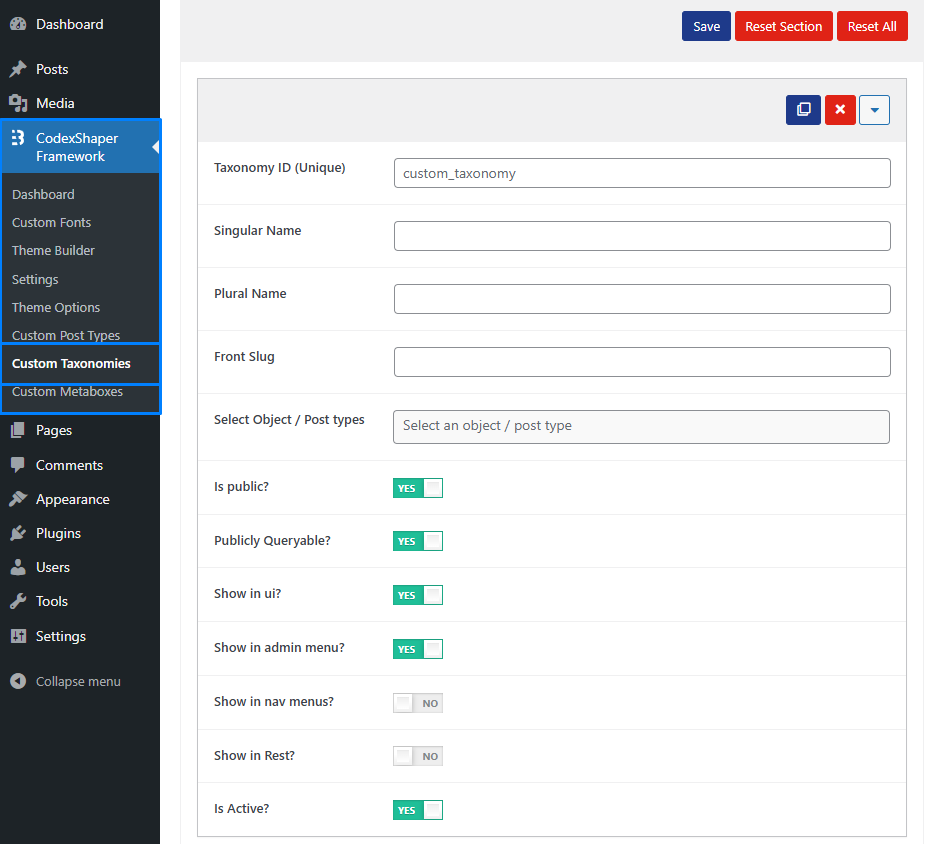Custom Taxonomy
1. Using Option Builder
A powerful Option Builder allows easy creation of taxonomies.
Example: Creating portfolio-category taxonomy for portfolio post type.
php
use CodexShaper\Framework\Builder\CustomTaxonomy;
CustomTaxonomy::create(
'custom_taxonomy',
array(
"taxonomy" => "custom_taxonomy",
"name" => "Custom Taxonomies",
"singular_name" => "Custom Taxonomy",
"search_items" => "Search Custom Taxonomies",
"all_items" => "All Custom Taxonomies",
"parent_item" => "Parent Custom Taxonomy",
"parent_item_colon" => "Parent Custom Taxonomy: ",
"edit_item" => "Edit Custom Taxonomy",
"update_item" => "Update Custom Taxonomy",
"add_new_item" => "Add New Custom Taxonomy",
"new_item_name" => "New Custom Taxonomy",
"menu_name" => "Custom Taxonomy",
"object_type" => array("portfolio"),
"hierarchical" => true,
"show_ui" => true,
"show_admin_column" => true,
"query_var" => true,
"rewrite" => array(
"slug" => "portfolio-categories",
"with_front" => false
),
"public" => true,
"publicly_queryable" => true,
"show_in_menu" => true,
"show_in_nav_menus" => false,
"show_in_rest" => false,
)
);| Argument | Type | Default | Description |
|---|---|---|---|
taxonomy | string | - | The unique identifier (slug) for the taxonomy (e.g., custom_taxonomy). |
name | string | - | Plural label for the taxonomy (e.g., “Books”). |
singular_name | string | - | Singular label (e.g., “Book”). |
search_items | string | - | Label for the search form placeholder (e.g., “Search Custom Taxonomies”). |
all_items | string | - | Label to display for all taxonomy terms (e.g., “All Custom Taxonomies”). |
parent_item | string | - | Label for a parent taxonomy item (e.g., “Parent Custom Taxonomy”). |
parent_item_colon | string | - | Label for parent taxonomy item with a colon (e.g., “Parent Custom Taxonomy:”). |
edit_item | string | - | Label for editing a taxonomy term (e.g., “Edit Custom Taxonomy”). |
update_item | string | - | Label for updating a taxonomy term (e.g., “Update Custom Taxonomy”). |
add_new_item | string | - | Label for adding a new taxonomy term (e.g., “Add New Custom Taxonomy”). |
new_item_name | string | - | Label for a newly created taxonomy term (e.g., “New Custom Taxonomy”). |
menu_name | string | - | Label for the taxonomy menu in the WordPress admin (e.g., “Custom Taxonomy”). |
object_type | array | array() | An array of post types to which this taxonomy applies (e.g., array('portfolio')). |
hierarchical | boolean | false | If true, the taxonomy behaves like categories (parent-child relationship). If false, it behaves like tags. |
show_ui | boolean | true | If true, the taxonomy is displayed in the WordPress admin UI. |
show_admin_column | boolean | false | If true, displays the taxonomy in its own column on the post type listing screen. |
query_var | boolean|string | true | Enables using the taxonomy’s name in WP queries (e.g., ?custom_taxonomy=term). |
rewrite | array | true | Controls permalink structure (e.g., 'slug' => 'portfolio-categories'). |
public | boolean | false | If true, the taxonomy is publicly available (front-end queries, permalinks, etc.). |
publicly_queryable | boolean | Matches public | If true, allows front-end queries. |
show_in_menu | boolean | false | If true, displays the taxonomy in the admin menu. |
show_in_nav_menus | boolean | false | If true, allows this taxonomy to be used in navigation menus. |
show_in_rest | boolean | false | If true, exposes the taxonomy in the WordPress REST API. |
2. Creating from Dashboard
Navigate to CodexShaper Framework >> Custom Taxonomies.

| Argument | Type | Default | Description |
|---|---|---|---|
Taxonomy ID | string | - | The unique identifier (slug) for the taxonomy (e.g., custom_taxonomy). |
Singular Name | string | - | Singular label (e.g., "Book"). |
Plural Name | string | - | Plural label for the taxonomy (e.g., “Books”). |
Front Slug | string | - | A slug that can be used for the front-end (optional). |
Select Object | string | - | Choose the post type (e.g., post, portfolio, or custom post type). |
Is Public | bool | true | Toggle to set if the taxonomy is public. |
Publicly Queryable | bool | true | Determines if this taxonomy can be queried in front-end requests. |
Show in UI | bool | true | Choose whether this taxonomy should appear in the UI. |
Show in Admin Menu | bool | true | Toggle to show or hide in admin menus. |
Show in Nav Menu | bool | false | Toggle to show or hide in navigation menus. |
Show in Reset | bool | false | If true, exposes the taxonomy in the WordPress REST API. |
Is Active | bool | true | Set this to Yes to activate the taxonomy. |
3. Creating Manually
Steps:
- Navigate to:sh
{project_root}/wp-content/plugins/codexshaper-framework/src/Taxonomies - Create a file using
UpperCamelCase.phpnaming convention (e.g.,PortfolioCategory.php). - Open the file in a text editor and insert the following code:
php
<?php
namespace CodexShaper\Framework\Taxonomies;
use CodexShaper\Framework\Foundation\Taxonomy;
if (!defined('ABSPATH')) {
exit();
}
class PortfolioCategory extends Taxonomy {
public function __construct() {
parent::__construct();
}
public function get_name() {
return 'portfolio-category';
}
public function get_object_type() {
return array('portfolio');
}
public function get_title() {
return join(' ', array_map('ucfirst', explode('-', $this->taxonomy)));
}
public function is_public() {
return true;
}
public function is_publicly_queryable() {
return true;
}
public function is_hierarchical() {
return true;
}
public function is_show_ui() {
return true;
}
public function is_show_in_rest() {
return true;
}
public function is_query_var() {
return true;
}
public function is_show_in_menu() {
return true;
}
public function is_show_in_nav_menus() {
return true;
}
}Done! Your custom taxonomy is now registered.